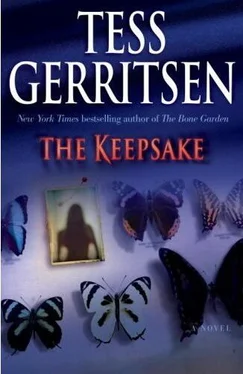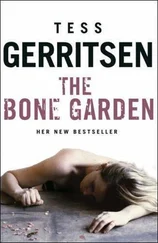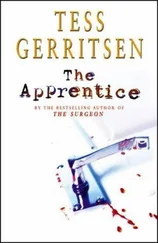Maura reached in her pocket for gloves. Her hands felt chilled and clumsy, and she fumbled in the darkness to pull latex over clammy fingers. As Jane aimed her beam up at the ledge, Maura gently pulled the head from its stone shelf. It felt startlingly weightless and was compact enough to rest in her palm. The curtain of hair was unbound, and she flinched as silky strands brushed across her bare arm. Not mere nylon, she thought, but real hair. Human hair.
Maura swallowed. “I think this is a tsantsa. ”
“A what?”
“A shrunken head.” Maura looked at Jane. “It seems to be real.”
“It could also be old, right? Just some antique the museum collected from Africa?”
“South America.”
“Whatever. Couldn’t these be part of their old collection?”
“They could be.” Maura looked at her in the darkness. “Or they could be recent.”
The museum staff stared at the three tsantsas resting on the museum’s lab table. Mercilessly lit by the glare of exam lights, every detail of the heads was illuminated, from their feathery eyelashes and eyebrows to the elaborate braiding of the cotton strings that bound their lips closed. Crowning two of the heads was long, jet-black hair. The hair of the third had been cut in a blunt bob that looked like a woman’s wig perched atop a far-too-small doll’s head. The heads were so diminutive, in fact, that they could easily be mistaken for mere rubber souvenirs, were it not for the clearly human texture of the brows and lashes.
“I have no idea why these were behind that wall,” Simon murmured. “Or how they got there.”
“This building is full of mysteries, Dr. Isles,” said Debbie Duke. “Whenever we update the wiring or fix the plumbing, our contractors find some new surprise. A bricked-up space or a passage that serves absolutely no purpose.” She looked across the table at Dr. Robinson. “You remember that fiasco with the lighting last month, don’t you? The electrician had to break down half the third-floor wall just to figure out where the wires tracked. Nicholas? Nicholas?”
The curator was staring so intently at the tsantsas that only when he heard his name called again did he glance up. “Yes, this building’s something of a puzzle,” he said. And he added, softly: “It makes me wonder what else we haven’t found behind these walls.”
“So these things are real?” asked Jane. “They’re actually shrunken human heads?”
“They’re definitely real,” said Nicholas. “The problem is…”
“What?”
“Josephine and I scanned all the inventory records we could locate. According to the accession ledgers, this museum does indeed have tsantsas in the collection. They were added in 1898, when they were brought back from the upper Amazon basin by Dr. Stanley Crispin.” He looked at Simon. “Your grandfather, I believe.”
Simon nodded. “I’d heard we had them in our collection. I never knew what became of them.”
“According to the curator who worked here in the 1890s, the items are described as follows.” Robinson flipped to the page in the ledger. “‘Ceremonial Jivaro trophy heads, both in excellent condition.’”
Registering the significance of that description, Maura glanced up at him. “Did you say both?”
Robinson nodded. “According to these records, there are only two in the collection.”
“Could a third have been added later, but never recorded?”
“Certainly. That’s one of the issues we’ve been struggling with, our incomplete records. That’s why I began the inventory, so I could finally get a handle on what we have.”
Maura frowned at the three shrunken heads. “So now the question is, which one is the new addition? And how recent is it?”
“I’m betting on her being the new one.” Jane pointed to the tsantsa with the bobbed hair. “I swear I saw a haircut just like that on my barista this morning.”
“First of all,” said Robinson, “it’s almost impossible to tell, just by appearance, if a tsantsa is male or female. Shrinking the head distorts the features and makes the sexes look alike. Second, the hair of some traditional tsantsas may be cut short like that one. They’re unusual, but the haircut doesn’t really tell us anything.”
“So how do you tell a traditional shrunken head from a modern copy?” asked Maura.
“You will permit me to handle them?” Robinson asked.
“Yes, of course.”
He crossed to the cabinet to get gloves and pulled them on as deliberately as a doctor about to perform delicate surgery. This man would be meticulous no matter what his profession, Maura thought. She could not remember any medical school classmate more exacting than Nicholas Robinson.
“First,” he said, “I should explain what constitutes a genuine Jivaro tsantsa. It was one of my particular interests, so I know a bit about them. The Jivaro people live along the border between Ecuador and Peru, and they regularly raid each other’s tribes. Warriors will take anyone’s head-men, women, children.”
“Why take the heads?” asked Jane.
“It has to do with their concept of the soul. They believe that people can have up to three different types of souls. There’s an ordinary soul, which is what everyone possesses at birth. Then there’s an ancient vision soul, and it’s something you have to earn through ceremonial efforts. It gives you special powers. If someone earns an ancient vision soul, and then he’s murdered, he transforms into the third kind-an avenging soul, who will pursue his killer. The only way to stop an avenging soul from exacting retribution is to cut off the head and turn it into a tsantsa. ”
“How do you make a tsantsa?” Jane looked down at the three doll-sized heads. “I just don’t see how you can shrink a human head down to something that small.”
“Accounts of the process are contradictory, but most reports agree on a few key steps. Because of the tropical environment, the process had to be started immediately after death. You take the severed head and slice open the scalp in a straight line, from the crown all the way to the base of the neck. Then you peel the skin away from the bone. It actually comes off quite easily.”
Maura looked at Jane. “You’ve seen me do almost the same thing at autopsy. I peel the scalp away from the skull. But my incision goes across the crown, ear to ear.”
“Yeah, and that’s the part that always grosses me out,” said Jane. “Especially when you peel it over the face.”
“Oh yes. The face,” said Robinson. “The Jivaro peel that off, too. It takes skill, but the face comes off, along with the scalp, all in one piece. What you have, then, is a mask of human skin. They turn it inside out and scrape it clean. Then the eyelids are sewn shut.” He lifted one of the tsantsas and pointed to the almost invisible stitches. “See how delicately it’s been done, leaving the eyelashes looking completely natural? This is really skillful work.”
Was that a note of admiration in his voice? Maura wondered. Robinson did not seem to notice the uneasy looks that Maura and Jane exchanged; he was focused entirely on the craftsmanship that had turned human skin into an archaeological oddity.
He turned the tsantsa over to look at the neck, which was merely a leathery tube. Coarse stitches ran up the back of the neck and the scalp, where they were almost hidden by the thick hair. “After the skin is removed from the skull,” he continued, “it’s simmered in water and plant juices, to melt away the last of the fat. When every last bit of flesh and fat is scraped away, it all gets turned right-side out again, and the incision in the back of the head is sewn up, as you can see here. The lips are fastened together using three sharpened wooden skewers. The nostrils and ears are plugged with cotton. At this point, it’s just a floppy sack of skin, so they stuff hot stones and sand into the cavity to sear the skin. Then it’s rubbed with charcoal and hung over smoke, until the skin shrinks down to the consistency of leather. This whole process doesn’t take long. Probably not more than a week.”
Читать дальше












